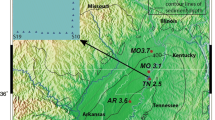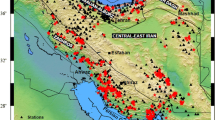Abstract
The stochastic estimation of coherency is perceived, in some studies, to be significantly influenced by the time window length under consideration. For the engineering purposes, usually, coherency is estimated from the strong motion, i.e., the shear (S-) wave segment of the recorded time series. However, the identification of a purely S-wave dominated window could be challenging in case of complex wave mixing on the seismograms. Moreover, there has been relatively little research on how much variation, in reality, is introduced in the coherency estimates owing to the choice of signal length. Therefore, the debate about the procedure for selecting a representative time window has remained inconclusive: different authors keep their different practices. The current article is an effort to shed light on the sensitivity of the coherency estimates to the choice of various time windows. The research draws on the dataset gathered from a dense seismic-array deployed at the small size, shallow alluvial valley of Koutavos-Argostoli, situated in Cephalonia Island, Greece. The lagged coherency over interstation distance ranges from 5 to 80 m has been estimated from a set of 46 earthquakes having magnitude 2–5 and epicentral distance 3–200 km, considering different lengths of time windows. The findings revealed that the statistics of coherency estimates derived from many events is only weakly sensitive to the selection of time window lengths provided that the segments include the same energetic pulse.
















Similar content being viewed by others
References
Abrahamson NA (1992) Spatial variation of earthquake ground motion for application to soil-structure interaction. Rpt. No. EPRI TR-100463, Tier 2, Palo Alto, CA
Abrahamson NA (2007) Program on technology innovation: effects of spatial incoherence on seismic ground motions. Rpt. No. EPRI 1015110, Palo Alto, CA
Abrahamson NA, Silva WJ (1996) Empirical ground motion models
Abrahamson NA, Schneider JF, Stepp JC (1991) Spatial coherency of shear waves from the Lotung, Taiwan large-scale seismic test. Struct Saf 10:145–162
Aki K (1969) Analysis of the seismic coda of local earthquakes as scattered waves. J Geophys Res 74(2):615–631
Arias A (1970) A measure of earthquake intensity. In: Hansen R (ed) Seismic design for nuclear power plants. MIT Press, Cambridge, pp 438–483
Bard P-Y, Bouchon M (1980) The seismic response of sediment-filled valleys. Part 1. The case of incident SH waves. Bull Seismol Soc Am 70:1263–1286
Bommer JJ, Stafford PJ, Alarcón JE (2009) Empirical equations for the prediction of the significant, bracketed, and uniform duration of earthquake ground motion. Bull Seismol Soc Am 99:3217–3233
Cornou C, Bard P-Y, Dietrich M (2003) Contribution of dense array analysis to basin-edge-induced waves identification and quantification, part II: application to Grenoble basin, French Alps. Bull Seismol Soc Am 93:2624–2648
Cultrera G, Andreou T, Boxberger T et al (2014) The Argostoli (Cephalonia, Greece) experiment. In: Proceedings of the second European conference on earthquake engineering and seismology (2ECEES), Istanbul, Turkey, 24–29 Aug 2014
Cushing EM, Hollender F, Guyonnet-Benaize C et al (2016) Close to the lair of Odysseus Cyclops: the SINAPS@ postseismic campaign and accelerometric network installation on Kefalonia island—site effect characterization experiment. In: McCalpin J, Gruetzner C (eds) Proceedings of the 7th INQUA on paleoseismology, active tectonics and archeoseismology, Crestone, Colorado, USA, 30 May–3 June 2016
Hao H, Oliveira CS, Penzien J (1989) Multiple-station ground motion processing and simulation based on SMART-I array data. Nucl Eng Des 111:293–310
Harichandran RS (1991) Estimating the spatial variation of earthquake ground motion from dense array recordings. Struct Saf 10:219–233
Imtiaz A (2015) Seismic wave field, spatial variability and coherency of ground motion over short distances: near source and alluvial valley effects. PhD thesis, Université Grenoble Alpes. NNT: 2015GREAU002. tel-01148138. https://tel.archives-ouvertes.fr/tel-01148138
Imtiaz A, Cornou C, Bard P-Y, Hobiger M (2014) Diffracted wave field and coherency analysis: an example from dense array network in Argostoli Basin, Cephalonia, Greece. In: Proceedings of the second European conference on earthquake engineering and seismology (2ECEES), Istanbul, Turkey, 24–29 Aug 2014. p 12, Paper # 2351
Imtiaz A, Cornou C, Bard P-Y, Zerva A (2015) Spatial coherence of seismic ground motion and geometric structure of the sub-surface: an example in Argostoli, Greece. In: 9th colloque national AFPS 2015. p 12
Imtiaz A, Cornou C, Bard PY, Zerva A (2017) Effects of site geometry on short-distance spatial coherency in Argostoli, Greece. Bull Earthq Eng. https://doi.org/10.1007/s10518-017-0270-z
Kishida T, Ktenidou O-J, Darragh RB, Walter S (2016) Semi-automated procedure for windowing time series and computing Fourier amplitude spectra (FAS) for the NGA-West2 database. PEER Rept. No. 2016/02, Pacific Earthq Eng Res Center, California, Berkeley 64
Moczo P, Bard P-Y (1993) Wave diffraction, amplification and differential motion near strong lateral discontinuities. Bull Seismol Soc Am 83:85–106
Perron V, Laurendeau A, Hollender F et al (2017) Selecting time windows of seismic phases and noise for engineering seismology applications: a versatile methodology and algorithm. Bull Earthq Eng. https://doi.org/10.1007/s10518-017-0131-9
Protopapa E, Papastamatiou DM, Gazetas G (1998) The Ionianet accelerometer array: early results and analysis. In: Proceedings of the 11th European conference on earthquake engineering, Balkema, Rotterdam, pp 1–8
Riepl J, Oliveira CS, Bard P-Y (1996) Analyse experimentale de la cohérence spatiale. In: 4ieme Colloque National de l’Association Française du Génie Parasismique, Saint-Rémy-lès-Chevreuse, France, 10–12 Apr 1996, pp 102–111
Riepl J, Oliveira CS, Bard P-Y (1997) Spatial coherence of seismic wave fields across an alluvial valley (weak motion). J Seismol 1:253–268
Scandella L, Paolucci R (2010) Earthquake induced ground strains in the presence of strong lateral soil heterogeneities. Bull Earthq Eng 8:1527–1546
Zerva A (2009) Spatial variation of seismic ground motions. CRS Press, Boca Raton, p 468
Zerva A, Stephenson WR (2011) Stochastic characteristics of seismic excitations at a non-uniform (rock and soil) site. Soil Dyn Earthq Eng 31:1261–1284
Zerva A, Zervas V (2002) Spatial variation of seismic ground motions: an overview. Appl Mech Rev ASME 55:271–297
Acknowledgements
The authors would like to thank all NERA partners who participated in the seismological experiment, especially Nikos Theodulidis, Giovanna Cultrera, Tobias Boxberger, and Tommy Andreou. Seismological data used in this paper have been acquired by using the stations from SISMOB which is a member of French Seismologic and Geodetic Network (RESIF—Réseau Sismologique et Géodésique Français). RESIF is a national Research Infrastructure recognized as such by the French Ministry of higher education and research. It is additionally supported by a public grant overseen by the French national research agency (ANR) as part of the “Investissements d’Avenir” program (reference: ANR-11-EQPX-0040) and the French Ministry of ecology, sustainable development and energy. The authors would like to take this opportunity to thank the editor and two anonymous reviewers for the insightful comments and suggestions, which have greatly helped to improve the manuscript. We believe that our results will open discussions about the way the time windows are to be considered in coherency analysis.
Author information
Authors and Affiliations
Corresponding author
Rights and permissions
About this article
Cite this article
Imtiaz, A., Cornou, C. & Bard, PY. Sensitivity of ground motion coherency to the choice of time windows from a dense seismic array in Argostoli, Greece. Bull Earthquake Eng 16, 3605–3625 (2018). https://doi.org/10.1007/s10518-018-0320-1
Received:
Accepted:
Published:
Issue Date:
DOI: https://doi.org/10.1007/s10518-018-0320-1




